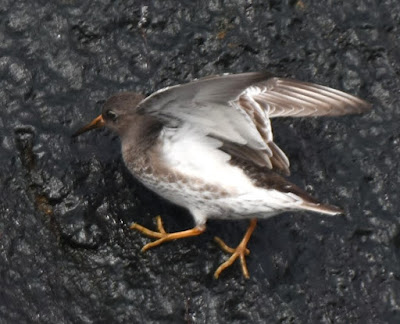Duck genetics can get pretty mixed up, and so can nature
lovers who try to make sense of what they see. Even though we're used to
noticing Mallards in very specific patterns the reality is more complicated
than that. Interbreeding among closely related groups is not unique to Mallards
nor even just to ducks. It may or may not be a "conservative"
occurrence, depending on perspective. Perhaps it "just is."
 |
R to L: Mallard male,
American Black Duck male, hybrid female |
The Mallard is a common and widespread species in the large,
fresh water duck genus Anas.
Other species in this genus frequently commingle with Mallards, especially American
Black Ducks. They're often seen together at Halibut Point.
%20with%20Mallard%20(f).jpg) |
Northern Pintail (f)
in foreground |
This female Northern Pintail Anas acuta currently in residence at Halibut
Point is fairly easy to distinguish from other Mallard-like ducks on the quarry
pond. It has 'pure' Pintail characteristics of diminutive size, buffy-brown
plumage, and gray legs and bill. But what about the bird to its rear in this
picture, with the wing bars of a female Mallard but the drab olive bill of an
American Black Duck? Its identity to ornithologists is more ambiguous. There's
a blurring at least of the edges.
 |
| A typical female American Black Duck Anas rubripes |
 |
| A typical female Mallard Anas platyrhynchos |
 |
| A Gadwall female, until recently Anas strepera |
Returning to the first photograph we can see that genes of a
dark colored heavy-bodied male American Black Duck (center) seem to have
influenced the appearance of the female duck standing on the left.
 |
| A Mallard x Gadwall x American Black Duck female hybrid? |
Enlarging that photo we can take further stock of this
bird's bill and plumage. It's possible that it exhibits Gadwall traits as well
as Mallard and American Black Duck.
 |
| Mallard male |
The male Mallard in the group is clearly characteristic of
its species and gender.
 |
| A male Mallard x American Black Duck cross |
Cross-breeding occurrences
produce ambivalent plumages among male offspring too.
 |
| The hybrid male with a Mallard female |
The drake in the photograph above blends American Black Duck
and Mallard characteristics, at the expense of the iridescent green head. The
female doesn't seem to mind, though it's a loss from our standpoint. Human
aesthetics, and taxonomy, do not necessarily enter into matters of natural
selection except insofar as they result in successful futures for the species.
Part of the concept of 'species' for both flora
and fauna is that it preserves a stable group identity for its members. But as we've seen, birds in the Anas genus sometimes make inter-species
pairings that produce viable offspring with mixed characteristics, especially
when closely related species flock together.
Favoritism by
humans has played a significant role in the increase of Mallards. According to
local naturalist Chris Leahy, they "were once uncommon spring and fall
migrants in New England. They only began to breed and to become common
permanent residents when people began introducing feral or captive-bred birds to private ponds and public parks.
Their superabundance can cause problems for native waterfowl and even human
health."
That puts humans in
the Mallard mix too.









%20with%20Mallard%20(f).jpg)




























